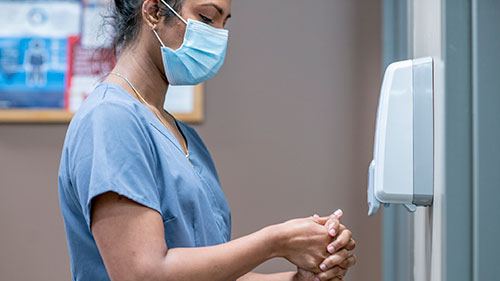Key points
- Group A Streptococcus (GAS) spread easily in long-term care facilities (LTCFs) once introduced.
- There are many opportunities for introduction of GAS into LTCFs from the community.
- Strong infection prevention and control practices are critical to stopping GAS transmission and preventing outbreaks in LTCFs.

Transmission factors
Once introduced into a facility, GAS can easily spread through multiple routes.
How the bacteria spread
Generally, GAS is transmitted from an infected or colonized person through
- Respiratory droplets
- Contact with saliva or nasal secretions
- Contact with open sores or wounds
Colonization rates by age
Children: Colonization with GAS is common. Up to 20% of asymptomatic school-aged children are colonized with GAS. About 25% of asymptomatic household contacts of children with streptococcal pharyngitis (i.e., strep throat) are colonized with GAS.
Adults: Colonization is less common. Among healthy adults, fewer than 5% are colonized with GAS in their throat.
Who usually brings the bacteria into LTCFs
GAS can be transmitted to others in a LTCF by1
- Residents
- Visitors
- Healthcare personnel (HCP)
Factors that affect spread within a LTCF
Spread of GAS among residents in LTCFs has been associated with the following:
- Having a roommate who's infected or colonized with GAS
- Being cared for by the same HCP as a resident who's infected or colonized with GAS
- Residing on the same unit as a resident who's infected or colonized with GAS
Multiple transmission routes
Point-source foodborne outbreaks of GAS have occurred in healthcare settings2 but are rare. GAS outbreaks in LTCFs are rarely point source or common source. A common-source outbreak is an outbreak in which all persons are exposed to infectious agents from the same source.
Instead, GAS outbreaks in LTCFs frequently involve multiple routes of transmission. Asymptomatic, colonized residents and HCP can serve as sources of GAS transmission during outbreaks. Additionally, multiple outbreak investigations have linked transmission to HCP with GAS pharyngitis who cared for patients while ill13.
Role of infection prevention and control
Multiple GAS outbreak investigations in LTCFs have identified lapses in infection prevention and control practices. Specifically, lapses were shown
Wound care can lead to shedding or spray of GAS into the environment or onto HCP performing wound care5.
Preventing outbreaks in LTCFs: Infection prevention and control is critical.
Interrupting transmission during outbreaks: Strengthening infection control practices, with special attention to good hand hygiene and wound care, is key.
Multi-facility outbreaks
LTCFs, especially those in close geographic proximity, may share HCP. Shared HCP may be a GAS transmission link between facilities. If public health officials identify cases in multiple nearby LTCFs, they should consider the possibility of a single, multi-facility outbreak.
In LTCFs experiencing cases of invasive GAS, it's especially important for public health to inquire about
- Wound care service providers
- Other external consultants
External consultants often work in multiple LTCFs.
Whenever possible, LTCFs with shared HCP should seek to
- Align policies and procedures (e.g., flexible sick leave policies)
- Establish procedures for communication when any shared HCP are placed on work restrictions
The goal is to ensure that HCP don't report to work when ill.
- Jordan HT, Richards CL, Burton DC, et al. Group A streptococcal disease in long-term care facilities: Descriptive epidemiology and potential control measures. Clin Infect Dis. 2007;45(6):742–52.
- Ertugrul BM, Erol N, Emek M, et al. Food-borne tonsillopharyngitis outbreak in a hospital cafeteria. Infection. 2012;40(1):49–55.
- Kobayashi M, Lyman MM, Francois Watkins LK, et al. A cluster of group A streptococcal infections in a skilled nursing facility: The potential role of healthcare worker presenteeism. J Am Geriatr Soc. 2016;64(12):e279–84.
- Dooling KL, Crist MB, Nguyen DB, et al. Investigation of a prolonged group A streptococcal outbreak among residents of a skilled nursing facility, Georgia, 2009–2012. Clin Infect Dis. 2013;57(11):1562–7.
- Ahmed SS, Diebold KE, Brandvold JM, et al. The role of wound care in 2 group A streptococcal outbreaks in a Chicago skilled nursing facility, 2015–2016. Open Forum Infect Dis. 2018;5(7):ofy145.
- Nanduri SA, Metcalf BJ, Arwady MA, et al. Prolonged and large outbreak of invasive group A Streptococcus disease within a nursing home: Repeated intrafacility transmission of a single strain. ClinMicrobiolInfect. 2019;25(2):248.e241–247.
